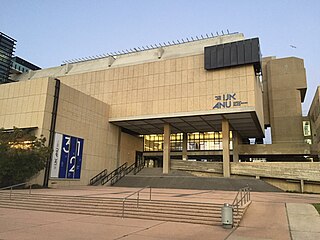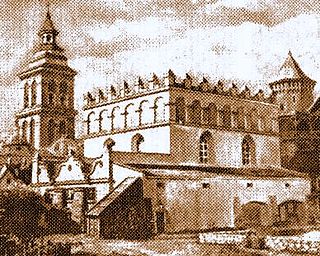
Cochin Jews are the oldest group of Jews in India, with roots that are claimed to date back to the time of King Solomon. The Cochin Jews settled in the Kingdom of Cochin in South India, now part of the state of Kerala. As early as the 12th century, mention is made of the Jews in southern India by Benjamin of Tudela. They are known to have developed Judeo-Malayalam, a dialect of Malayalam language.

Anu – Museum of the Jewish People, formerly the Nahum Goldmann Museum of the Jewish Diaspora, is located in Tel Aviv, Israel, at the center of the Tel Aviv University campus in Ramat Aviv. The Hebrew Anuאנו means 'we, us'.

The Jewish–Roman wars were a series of large-scale revolts by the Jews of Judaea and the Eastern Mediterranean against the Roman Empire between 66 and 135 CE. The First Jewish–Roman War and the Bar Kokhba revolt were nationalist rebellions, striving to restore an independent Judean state, while the Kitos War was more of an ethno-religious conflict, mostly fought outside the province of Judaea. As a result, there is variation in the use of the term "Jewish-Roman wars." Some sources exclusively apply it to the First Jewish-Roman War and the Bar Kokhba revolt, while others include the Kitos War as well.

Egyptian Jews constitute both one of the oldest and one of the youngest Jewish communities in the world. The historic core of the Jewish community in Egypt mainly consisted of Egyptian Arabic speaking Rabbanites and Karaites. Though Egypt had its own community of Egyptian Jews, after the Jewish expulsion from Spain more Sephardi and Karaite Jews began to migrate to Egypt, and then their numbers increased significantly with the growth of trading prospects after the opening of the Suez Canal in 1869. As a result, Jews from many territories of the Ottoman Empire as well as Italy and Greece started to settle in the main cities of Egypt, where they thrived. The Ashkenazi community, mainly confined to Cairo's Darb al-Barabira quarter, began to arrive in the aftermath of the waves of pogroms that hit Europe in the latter part of the 19th century.

The Knesset Eliyahoo, also Knesset Eliyahu, is an Orthodox Jewish synagogue located in downtown Mumbai, India. It is the city's second oldest Sephardic synagogue. It was established in 1884 by Jacob Elias Sassoon, son of Eliyahoo David Sassoon and grandson of David Sassoon; the latter had immigrated from Baghdad to India in 1832 due to persecution and had settled in Mumbai, then known as Bombay. It is maintained by the Jacob Sassoon Trust. The building's significance is attributed to its Jewish traditions as well as Indian and English colonial influences.

Zamość Synagogue is a UNESCO-protected Renaissance synagogue built between 1610 and 1618 in Zamość, southeastern Poland. Erected during the times of the Polish–Lithuanian Commonwealth, it functioned as a place of worship for Polish Jews until World War II, when the Nazis turned the interior into a carpenters' workshop. The structure was spared from destruction and in 1992 it became a UNESCO World Heritage Site alongside the Old City of Zamość.
The Jews of San Nicandro are a small community of proselytes from San Nicandro Garganico, Italy. The San Nicandro Jews are descended from local non-Jewish families from the 15th century. According to John A. Davis, professor of Italian history at the University of Connecticut, the Jews of San Nicandro represent "the only case of collective conversion to Judaism in Europe in modern times".

The Ramban Synagogue is the second oldest active synagogue in the Old City of Jerusalem, after only the Karaite Synagogue. It dates back in its current location to sometime around 1400. Tradition holds that as an institution, it was founded by the scholar and rabbi Moshe ben Nachman, also known as Nachmanides or Ramban, in 1267, but at a more southerly location on Mount Zion, to help rebuild the local Jewish community, which indeed expanded because of the synagogue's presence. The synagogue was moved to its current location around 1400, where it was destroyed in 1474, rebuilt in 1475, and continued functioning until being closed by the Muslim authorities in the late 16th century. The building was used for industrial and commercial purposes until its destruction in the 1948 Jordanian siege of the Jewish Quarter. After the 1967 Six-Day War, it was rebuilt over the old ruins and reconsecrated as a synagogue.

Coptic Cairo is a part of Old Cairo which encompasses the Babylon Fortress, the Coptic Museum, the Hanging Church, the Greek Church of St. George and many other Coptic churches and historical sites. It is believed in Christian tradition that the Holy Family visited this area and stayed at the site of Saints Sergius and Bacchus Church. Coptic Cairo was a stronghold for Christianity in Egypt both before and during the Islamic era, as most of its churches were built after the Muslim conquest of Egypt in the 7th century.
Alberto Hemsi was a composer of the 20th century classical era. His work in the field of ethnomusicology and integration of Sephardic melodies has been noted as parallel to Béla Bartók's collection of traditional Hungarian music and consequent integration to his music.

The Golden Rose Synagogue, known also as the Nachmanowicz Synagogue, or the Turei Zahav Synagogue was a synagogue in Lviv, western Ukraine. The Golden Rose Synagogue was the oldest synagogue in what is now Ukraine.

The Bukharan Quarter, also HaBukharim Quarter or Bukharim Quarter, is a neighborhood in the center of Jerusalem, Israel. The neighborhood was established by Bukharan Jews of the Old Yishuv. The neighborhood also anchored communities from modern-day Afghanistan and the Iranian city of Meshad. It belonged to the early Jewish neighborhoods built outside the Old City of Jerusalem as part of a process which began in the 1850s. Today most of the residents are Haredi Jews.
Green Synagogue is a synagogue in Alexandria, Egypt.

Menasce Synagogue is a synagogue in Alexandria, Egypt in Ahmed Orabi Square.
The Jobar Synagogue was an ancient synagogue complex destroyed in May 2014. Also known as the Eliyahu Hanavi Synagogue it was situated in the village of Jobar now encompassed by the metropolitan area of the City of Damascus. It was once adjoined to a complex with rooms for the rabbi and other functionaries of the community. The synagogue was built atop a cave traditionally thought to have served the prophet Elijah in hiding. The hall center was said to be the place where Elijah anointed Elisa. During the Syrian civil war it was hit by mortar bombs, looted, and later 2/3 of the synagogue were totally destroyed at the end of May 2014.

Joseph de Picciotto Bey was a Sephardi Jewish senator appointed by Fuad I of Egypt (1924), an expert in economics, and a member of the board of directors of several companies, among them the bank Cassa di Sconto e di Risparmio.

The Choral Synagogue of Vilnius is the only synagogue in Vilnius that is still in use. The other synagogues were destroyed partly during World War II, when Lithuania was occupied by Nazi Germany, and partly by the Soviet authorities after the war.
The following is a timeline of the history of the city of Alexandria, Egypt.

The Great German Synagogue is one of five synagogues in the Jewish Ghetto of Venice, Italy. Established in 1528, it is the oldest Venetian synagogue.
The history of the Jews in Alexandria dates back to the founding of the city by Alexander the Great in 332 BCE. Jews in Alexandria played a crucial role in the political, economic, cultural and religious life of Hellenistic and Roman Alexandria, with Jews comprising about 35% of the city's population during the Roman Era. Alexandrian Jewry were the founders of Hellenistic Judaism and the first to translate the Torah from Hebrew to Koine Greek, a document known as the Septuagint.














